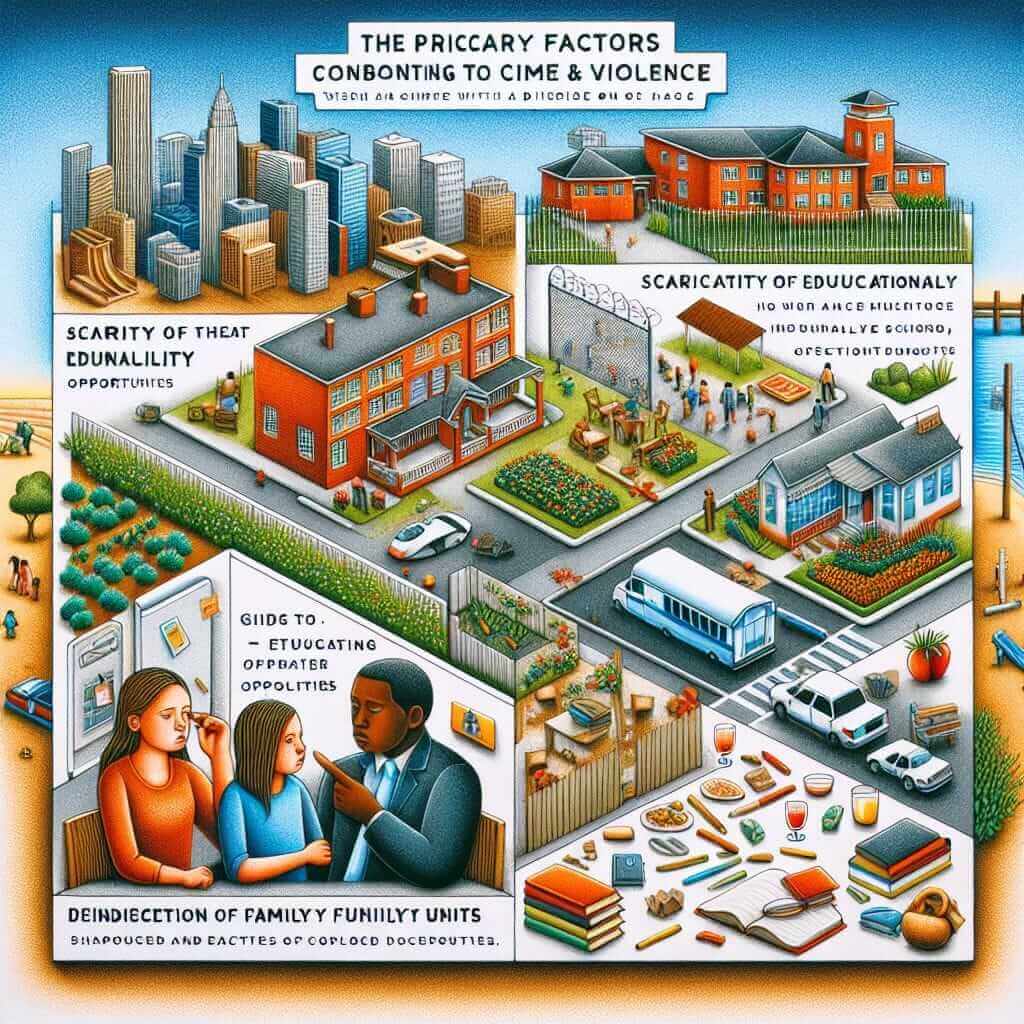Understanding the causes of crime and violence is a crucial topic in many IELTS exams, especially in writing and speaking sections. By mastering this topic, you can develop a comprehensive understanding and use it effectively in your test. This article will provide detailed insights into the causes of crime and violence, supported by examples, and guide you on how to utilize this knowledge in IELTS exams.
Understanding the Causes of Crime and Violence
Crime and violence are pervasive issues in many societies, often rooted in a variety of social, economic, and psychological factors. Below are some of the primary causes:
-
Poverty and Economic Inequality: Economic hardships can lead to criminal activities as individuals seek ways to meet basic needs.
Example: A study found that unemployment rates correlate strongly with increased crime rates in various countries.
-
Lack of Education: Limited access to education can result in fewer opportunities for legitimate employment, leading some to resort to crime.
Example: Areas with low literacy rates often report higher crime rates compared to more educated regions.
-
Family Breakdown: Dysfunctional family environments can lead to antisocial behavior in children, increasing the likelihood of criminal activities.
Example: Juvenile delinquency is often higher in communities with high rates of single-parent families.
-
Substance Abuse: Drug and alcohol addiction can lead to criminal behavior either to support the addiction or due to impaired judgment.
Example: A significant percentage of violent crimes are committed under the influence of drugs or alcohol.
-
Peer Pressure and Social Influence: Young individuals might be influenced by peers to engage in illegal activities or violence.
Example: Gangs often recruit members from vulnerable youth populations, leading to increased crime rates.
Examples and Illustrations
To effectively prepare for the IELTS exam, it’s important to incorporate these points into your essays and speaking responses. Here are some examples:
Writing Task 2
Question: What are the causes of crime and violence, and what could be done to reduce it?
Sample Answer:
One of the primary causes of crime and violence is poverty. In many cases, individuals who face economic hardships are more likely to engage in criminal activities to fulfill their basic needs. For instance, research has shown a strong correlation between unemployment rates and crime levels in numerous countries. Additionally, a lack of education often leads to limited job opportunities, which can push individuals towards illegal means to earn a living. To illustrate, regions with low literacy rates tend to have higher crime rates compared to better-educated regions.
Moreover, family breakdown can significantly contribute to crime rates. Children who grow up in dysfunctional families are more prone to developing antisocial behaviors, which could result in criminal activities. For example, juvenile delinquency rates are notably higher in communities with substantial single-parent families. Substance abuse, including drug and alcohol addiction, also plays a crucial role. Many violent crimes are committed under the influence of substances, which impair judgment and increase aggressive tendencies.
To address these issues, governments and communities should focus on providing economic support, enhancing educational opportunities, and fostering strong family structures. Furthermore, implementing effective rehabilitation programs for substance abusers can significantly reduce crime rates.
 Causes of Crime and Violence
Causes of Crime and Violence
Speaking Part 3
Question: Why do you think crime rates are higher in some areas compared to others?
Sample Answer:
Crime rates tend to be higher in areas where poverty and economic inequality are prevalent. For instance, individuals who struggle to meet their basic needs might resort to criminal activities as a means of survival. Additionally, regions with limited access to education often have higher crime rates. This is because educational opportunities can provide individuals with legitimate means of income, reducing the likelihood of engaging in illegal activities. Furthermore, communities experiencing a family breakdown are more susceptible to elevated crime rates. Children who grow up in such environments are at a higher risk of turning to crime. Lastly, substance abuse also contributes significantly, as many crimes are committed under the influence of drugs or alcohol.
Common Mistakes and How to Avoid Them
When dealing with this topic in your IELTS exam, be aware of the following common mistakes:
- Overgeneralization: Avoid making sweeping statements without evidence. Always support your points with specific examples or data.
- Ignoring Other Causes: Crime and violence can result from multiple factors. Ensure that you discuss a range of causes to present a balanced argument.
- Lack of Structure: A well-organized answer is crucial. Use clear paragraphs and logical sequencing of ideas to enhance readability.
Practice Tips
- Research and Lists: Create lists of vocabulary and expressions related to crime and violence. Practice using them in sentences.
- Timed Writing: Practice writing essays on this topic within the IELTS time limits to enhance your time management skills.
- Simulate Speaking Tests: Practice answering speaking questions with a friend or tutor to build confidence and fluency.
Conclusion
Understanding the causes of crime and violence and being able to discuss them effectively can significantly enhance your performance in the IELTS exam. By incorporating well-supported arguments and avoiding common pitfalls, you can provide comprehensive and coherent answers. Remember to practice regularly and seek feedback to improve.
For more insights and strategies on how to excel in your IELTS exam, explore our website at IELTS.NET – Learning IELTS Online. Feel free to leave comments or questions below, and happy studying!


